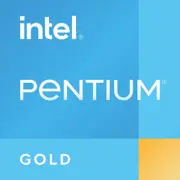Intel Pentium Gold 7505

Intel Pentium Gold 7505: 日常作業向けの予算プロセッサ
2025年4月
アーキテクチャとプロセス:10nm SuperFinとモバイル最適化
Intel Pentium Gold 7505プロセッサは、Tiger Lakeシリーズの一部として発表され、エネルギー効率とコンパクトさが重視される予算ノートパソコン向けに設計されています。
コア、スレッド、クロック周波数
- 2コア / 4スレッド:ベース周波数は2.0GHz、Turbo Boost時の最大周波数は3.5GHzまで。
- 10nm SuperFin:このプロセスは、前世代の14nmチップ(例:Pentium Gold 6405U)に比べて、熱の発生が少なく、エネルギー消費が改善されています。
統合グラフィックス
- 第11世代Intel UHD Graphics:48の実行ユニット(EU)、HDMI 2.0またはDisplayPortを介して4K@60Hzをサポート。
- 技術:AV1デコーディングをサポートし、動画ストリーミングに便利で、基本的なゲームに向けてDirectX 12もサポートしています。
電力消費とTDP:パフォーマンスとバッテリー寿命のバランス
- TDP 15W:ウルトラブック向けの一般的な値。最小負荷時の消費は5〜7Wに減少します。
- 熱設計:一部の薄型デバイス(例:Chuwi Minibook X)ではパッシブ冷却が可能です。
パフォーマンス:Pentium Gold 7505の能力は?
Geekbench 6のテスト結果(1353 / 2590)は、Intel Core i3第10世代に匹敵するレベルで、エネルギー効率が改善されています。
実際のタスク
- オフィス作業:ブラウザ(10以上のタブ)、Microsoft Office、Zoomを問題なく処理できます。
- マルチメディア:YouTubeでの4K動画ストリーミング、Shotcutでの簡単な動画編集(複雑なエフェクトではラグがあります)。
- ゲーム:
- CS:GO — 低設定(720p)で40〜50FPS。
- Minecraft — 50〜60FPS(1080p、最低画質)。
- 現代のAAAゲーム(例:Cyberpunk 2077)は推奨されません。
Turbo Boostモード
- 短期負荷(例:重いPDFの表示):周波数は3.5GHzに上昇します。
- 長期負荷(動画のレンダリング):冷却制限のため、周波数は2.8〜3.0GHzに安定します。
使用シナリオ:このプロセッサは誰に向いているか?
1. 学生:テキスト入力、プレゼンテーション、オンラインコース向け。
2. オフィススタッフ:メール、スプレッドシート、企業アプリケーションの操作。
3. 家庭用ユーザー:Netflixの視聴、SNS、ビデオ通話。
4. 旅行者:長時間稼働できるコンパクトなノートパソコン(例:Lenovo IdeaPad Slim 3)。
向いていない:ゲーマー、デザイナー、CADを扱うエンジニア。
バッテリー寿命:ノートパソコンはどれくらい持つか?
- 作業時間:
- ウェブサーフィン — 8〜10時間(バッテリー容量50Whの場合)。
- 動画 — 最大12時間(AV1のハードウェアデコーディングのおかげで)。
- 省エネ技術:
- Intel Speed Shift:周波数の動的制御。
- C-States:未使用コアをスリープモードに移行。
競合製品との比較
AMD Ryzen 3 5425U(Zen 3、4コア / 8スレッド)
- 長所:優れたマルチスレッド性能(Geekbench 6マルチコア約3200)。
- 短所:ノートパソコンの価格が高い(Pentiumの$350に対し、$450から)。
Apple M1(ベースモデルのMacBook Air)
- 長所:2〜3倍のパフォーマンス、18時間のバッテリー寿命。
- 短所:$999からの価格、Windowsソフトウェアとの互換性が制限されている。
Intel Core i3-1115G4(2コア / 4スレッド)
- 長所:最大4.1GHzの周波数、シングルスレッドタスクで15〜20%速い。
- 短所:ノートパソコンが$50〜100高い。
Pentium Gold 7505の長所と短所
強み:
- ノートパソコンの低価格($300から)。
- 現代の基準をサポート:Wi-Fi 6、Thunderbolt 4(一部モデルにて)。
- 日常作業に対する十分なパフォーマンス。
弱み:
- コア数が2つのみ:マルチタスクが制限される(例:Photoshopとブラウザを同時に起動すると遅延が発生)。
- PCIe 4.0をサポートしていない:SSDはPCIe 3.0 x4(最大3.5GB/s)で動作。
ノートパソコン選びの推奨事項
1. デバイスの種類:ウルトラブック(Acer Swift 1)またはコンパクトノートパソコン(HP 14s-dq)。
2. RAM:最低でも8GB(将来的な余裕のために16GBを推奨)。
3. ストレージ:SSD(256GB以上)は必須。
4. ディスプレイ:フルHD(1920×1080) — 目の疲れが少ない。
5. 追加:充電に対応したUSB-Cの有無を確認。
2025年モデルの例:
- ASUS Vivobook Go 14($329):8GB RAM、256GB SSD、14" FHD。
- Dell Inspiron 15 3520($349):8GB RAM、512GB SSD、HDDスロット。
最終結論:Pentium Gold 7505は誰に向いているか?
このプロセッサは、基本的な作業向けの手頃な価格のノートパソコンを探している人に適しています。その主な利点:
- 価格:類似のRyzen 3やCore i3よりも安いデバイス。
- エネルギー効率:充電なしで最大10時間の稼働が可能。
- 最新技術:Wi-Fi 6やThunderbolt 4のサポート。
購入を推奨:
- 学生の学習用。
- 退職後のコミュニケーションや趣味用。
- オフィスでの企業デバイスとして。
代替案を探すべきは:
- ゲーマー — Ryzen 5やIntel Core i5のディスクリートグラフィック搭載モデルを検討。
- フリーランサー — Core i5 / Ryzen 5と16GB RAMを推奨。
ノートパソコンの価格帯:$300〜$400(新モデル、2025年)。$500以上の予算がある場合は、より高性能なCPUを選ぶ価値があります。
基本
CPUの仕様
メモリ仕様
GPUの仕様
その他
ベンチマーク
他のCPUとの比較
ソーシャルメディアで共有する
または当サイトへのリンクを追加
<a href="https://cputronic.com/ja/cpu/intel-pentium-gold-7505" target="_blank">Intel Pentium Gold 7505</a>